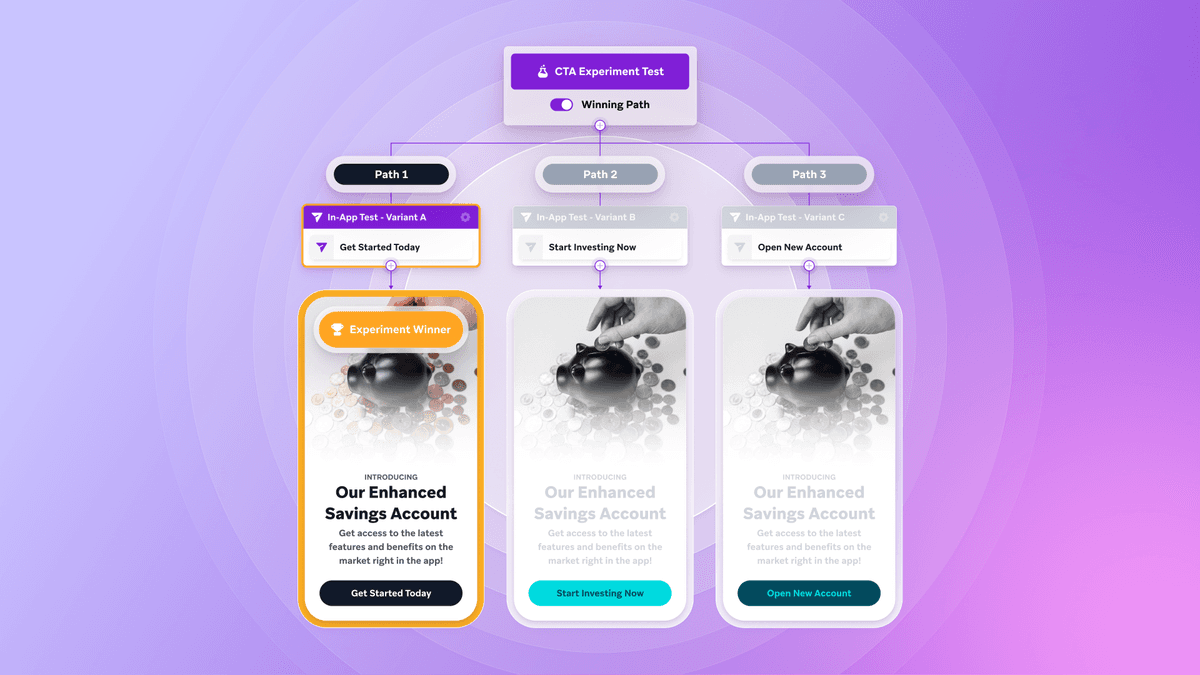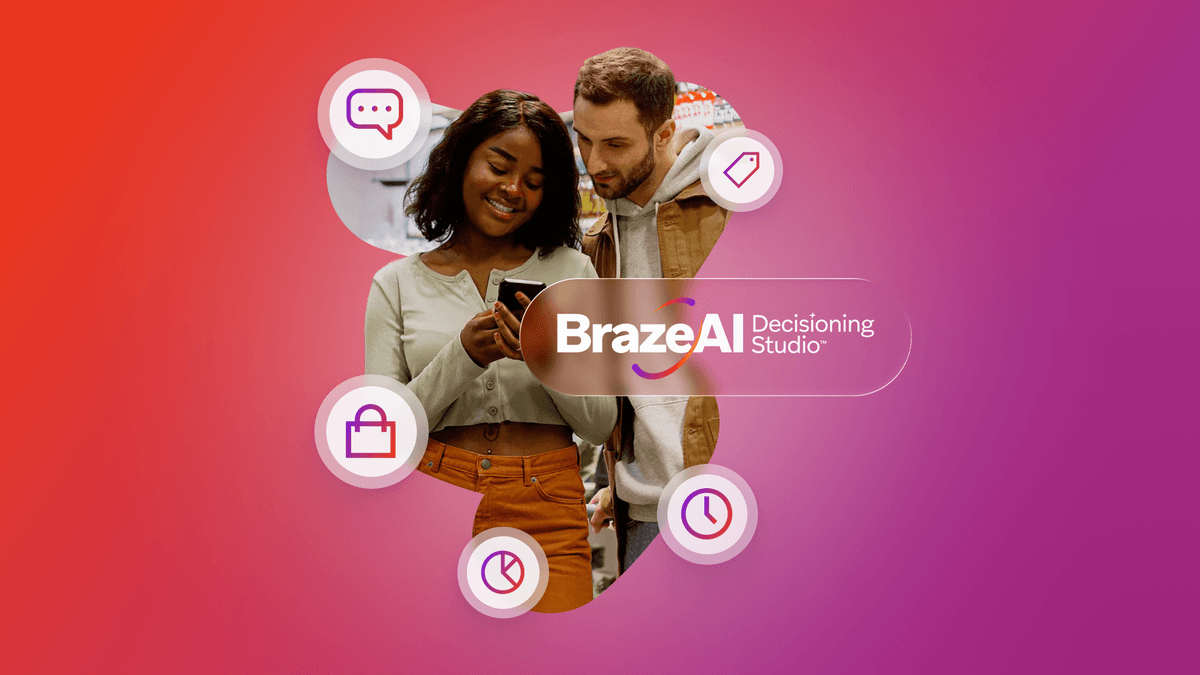5 Winning Campaigns to Get You Started with In-App Messages
Published on October 26, 2015/Last edited on October 26, 2015/10 min read

Published on October 26, 2015/Last edited on October 26, 2015/10 min read


You need a better way to engage the people who use your app or visit your website. You want to diversify your outreach beyond just push or email or just push and email. You haven’t used in-app messages much (or at all) but you’re looking to change that.
This piece is for you.
Where do you start? You start right here. We’re going to walk you through five simple campaigns that you can create that use in-app messages in smart, effective ways.
[Not sure exactly what an in-app message is, or what the benefits of using them are? Check out our piece on In-App Messaging: The Versatile Channel You’re Probably Not Using (But Should Be!) to get up to speed.]
According to comScore, while smartphone owners use an average of 25 apps per month, about 80% of their app time is focused on their top three favorites. When a new customer downloads your app, that puts a lot of pressure on that first session. People who leave without a clear idea of what your app is, how it works and how to use it effectively don’t really have a reason to return. And many won’t.
Good onboarding campaigns can fill this gap by welcoming new customers with the information they need in order to become engaged.
By creating an onboarding campaign, you’re making sure that the first impression that each customer gets after opening your app is a useful one. Onboarding should sell them on your app’s value and give them the tips they need to experience that value for themselves. Not everyone who receives an onboarding campaign is going to return to your app, engage fully, spend heaps of money and rave about your brand to all their friends – but the people who do are going to be the ones who understand your app, use it effectively and see results they’re happy with.
Some mobile brands build their customer onboarding process directly into the app. That can work well, but it tends to take a lot of engineering time and resources. In-app messages, on the other hand, can match the look and feel of your app but can be put together by marketers, making it easier to create and adjust your app’s onboarding experience.
Because in-app messages only appear when a customer is actively engaging with your app, they feel like part of the larger app experience and engage new customers with an educational approach. That’s a good fit for the onboarding experience which, at its core, is about showing new customers what they can do with your app and how they can do it.
Imagine your app gives customers access to on demand tie-dying of shirts, shoes, or whatever other items they want. When a new customer downloads your app, there are certain things that you need to make sure they understand immediately – what your app offers them, how the app works and what they need to do to use it and get value from it.
That means that you should create in-app messages covering that information:
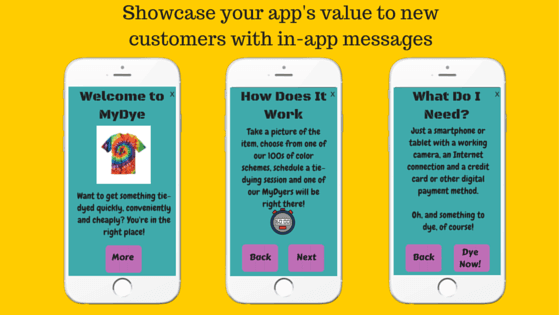
By keeping the onboarding quick, simple and focused on the essentials, you’re making it easy for interested customers to start using your product. By using in-app messages, you’re conveying that information in an unobtrusive way and simplifying future updates to the onboarding process.
Every time someone opens your app or visits your website, they’re carrying out a number of potential actions – clicking links, reading content, making purchases and more. That information helps you better understand each customer and how they’re engaging with your brand. But these actions also create opportunities for trigger campaigns.
Here’s how it works: when a customer carries out an action that you’ve selected as a trigger, they’ll receive a message from you. These campaigns can be a great way to point individuals to content they’ll find valuable, lengthen the time they spend in your app, and otherwise encourage deeper customer engagement.
If someone is already using your app or visiting your website, it makes sense to take advantage of the messaging channel that reaches active users – and that’s in-app messaging. For trigger campaigns connected to in-app or on-site customer behavior, in-app messages let you reach customers in an organic manner without pulling them out of your app or web experience.
Imagine your brand has created a gaming app. When customers access your site or open your app, you’ll be collecting information about their actions within the game that you can use to drive trigger campaigns.
Maybe your brand isn’t happy with the rating that the game currently has on Apple’s App Store or Google Play. Customers who regularly use your app are particularly likely to have a positive view of your brand, since they voluntarily come back again and again, and that makes them exactly the sort of people you want rating your app.
To improve your ratings, set up a trigger campaign that sends an in-app message encouraging customers to rate your app when they reach a milestone like 10 sessions. That will nudge engaged customers to carry out the action you want without hitting lapsed members of your audience who might be less willing to rate your app or more inclined to give it a bad rating.
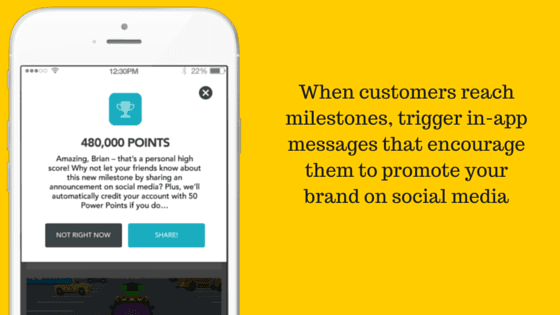
It’s possible to take this kind of trigger campaign a step further. Just set up a trigger campaign triggered when a player reaches a certain score in your game that sends them an in-app message praising their achievement and encourages them to share the news on social media. They’ll feel good about what they’ve accomplished and your app will get some free publicity to boot.
This kind of campaign is great for games, but it can work for any app with clearly-defined usage milestones (points, levels, etc.). For example, if your brand has an app that helps customers learn French, you could trigger an in-app message when someone completes enough lessons to be considered conversant, congratulating them and encouraging them to spread the news with a social media post. The important thing is to tie the message to a milestone that customers will care about; otherwise, they have no incentive to take you up on your suggestion.
Sometimes, customers will use your app or visit your website, but won’t engage with the push notifications or email outreach you send their way. Maybe they find push notifications irritating or don’t check their email very often. Or maybe what you sent just didn’t catch their interest – it happens sometimes.
If it’s important that those customers receive the information you’re trying to share with them, retargeting campaigns are a good way to give your messaging a second chance to resonate. In a way, retargeting campaigns are like trigger campaigns – except they trigger a message when a customer doesn’t engage with an earlier message, rather than when they reach a milestone or carry out an action.
When you’re setting up a retargeting campaign that’s aimed at active customers, using in-app messages lets you reach them where they are: in your app or on your website. Not every one of these customers will choose to engage with that second message, but you can be sure that they’ll see it – barring some deeply unlikely situation (apocalypse?!), in-app messages will reach anyone you send them to who opens your app or visits your website.
Imagine that your company offers customers discounted prices on coffee at shops in their area if they use your app or mobile website to pay. Your business model depends on a large number of people using your service, so when you announce a major new feature or unusually large discount, it’s important to make sure your customer base knows about it.
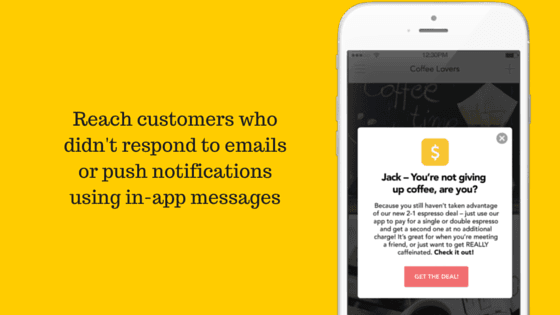
You’ll probably start out by sending a push notification and/or email to your audience – that will reach a big swath of your customers. To reach the subset of customers who regularly visit your app or website but who didn’t engage with that initial outreach, you can create a retargeting campaign that follows up with a related in-app message. It’ll pop up the next time they’re on your site or in your app, but only for them; customers who did click on your first message won’t see it.
Want to reach customers who clicked on that first campaign but didn’t make a purchase? You can create a retargeting campaign that sends them an in-app message the next time they visit your app or website encouraging them to take another look at the deal. In theory, it’s possible to just keep retargeting customers over and over if they don’t carry out the conversion you want, but be careful about overdoing it – at a certain point, you run the risk of alienating the people you’re trying to engage.
This one is pretty simple – it’s a messaging campaign that you use to showcase a sale, giveaway or other significant promotional event. For a lot of brands, this kind of messaging has the potential to drive additional purchases if the messages reach and engage the right customers.
When you send an in-app message, you’re reaching the people who are using your app or visiting your website RIGHT NOW. They’re the digital equivalent of shoppers browsing around a brick and mortar store. Because they’ve chosen to check out your brand’s digital presence, receiving a message from you won’t be an interruption – it’ll be directly relevant to what they’re currently doing. And that makes them a very receptive audience for campaigns highlighting sales and other promotions.
Imagine that your brand sells furniture online and you wants to promote an upcoming sale. You want to be sure that you reach the people who choose to visit your website during the promotion, as well as other potential customers who wouldn’t necessarily stop by without a nudge. By including in-app messaging as part of your multi-channel outreach, you can check both of those boxes.
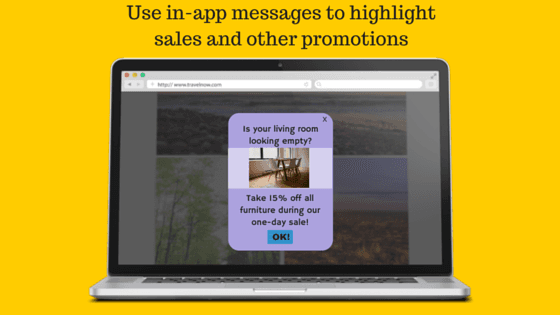
Kick off your campaign with in-app messages announcing the promotion – that will let you reach all the people who visit your website during the sale, driving the ones who are interested to a page where they can start shopping. Then send out an email promoting the sale to the customers who have given you their email addresses and include a link that will direct them to your website. As the sale gets close to its end, send out push notifications to let anyone who hasn’t made a purchase know that their window of opportunity is closing, encouraging those last-minute impulse buys.
Sign up for regular updates from Braze.


